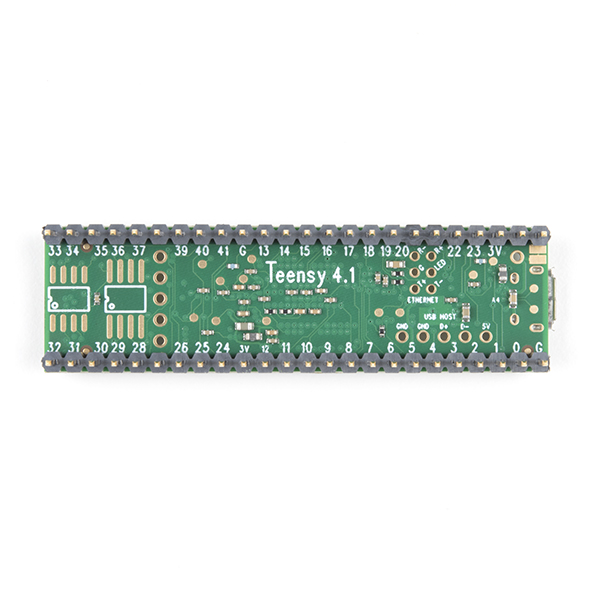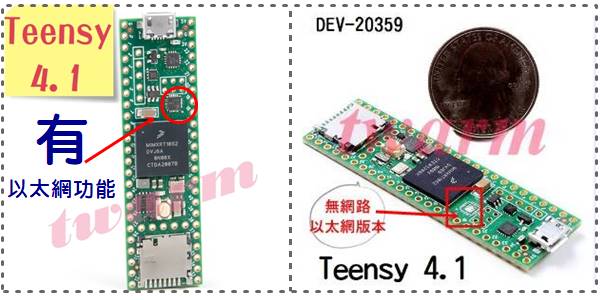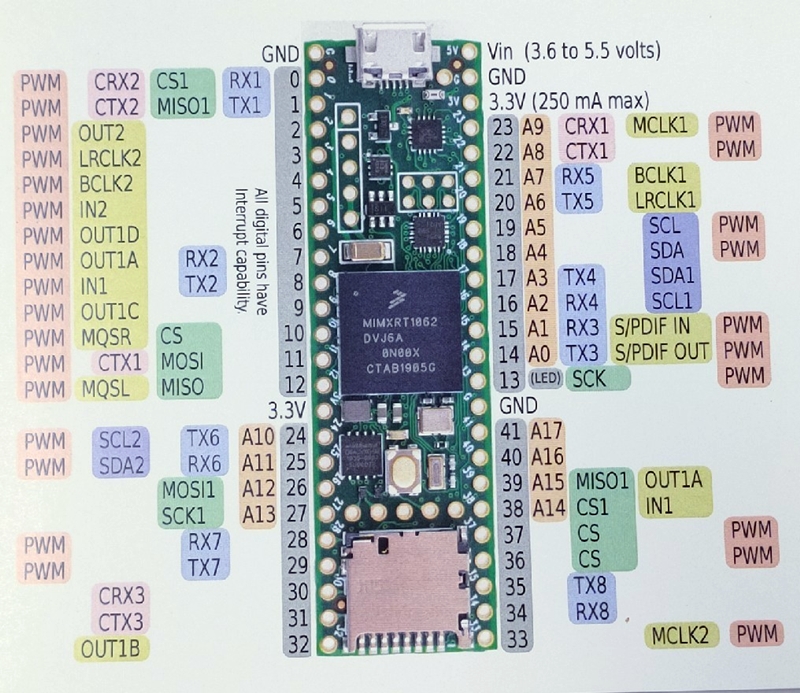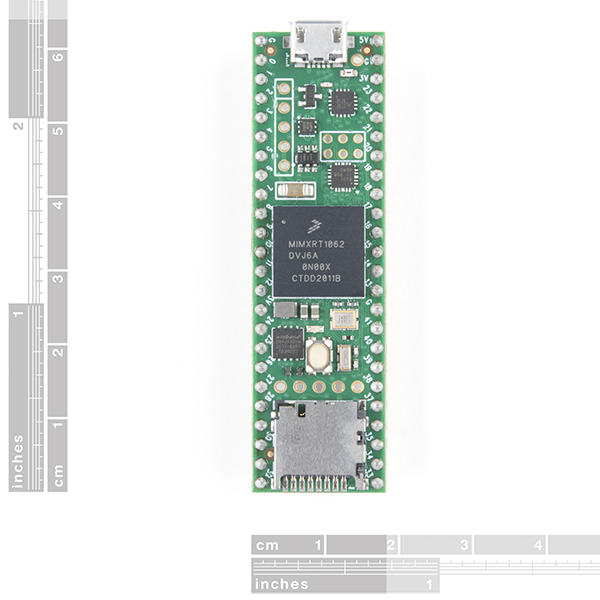※本產品原廠代理從國外進口,有些交期較長,下訂前請詢問!



Sparkfun原廠 Teensy 4.1 開發板 (DEV-16771)
影片:https://youtu.be/jDihQXEuhzI

The Teensy 4.1 is the newest iteration of the astoundingly popular development platform that features an ARM Cortex-M7 processor at 600MHz, with a NXP iMXRT1062 chip, four times larger flash memory than the 4.0, and two new locations to optionally add more memory. The Teensy 4.1 is the same size and shape as the Teensy 3.6 (2.4in by 0.7in), and provides greater I/O capability, including an ethernet PHY, SD card socket, and USB host port. The best part of this version of Teensy 4.1 is that it includes headers already attached. No soldering is required allowing you to get started as quickly as possible!
Teensy 4.1 是廣受歡迎的開發平台的最新版本,具有 600MHz 的 ARM Cortex-M7 處理器、NXP iMXRT1062 芯片、比 4.0 大四倍的閃存,以及兩個可以選擇添加更多內存的新位置。Teensy 4.1 的尺寸和形狀與 Teensy 3.6 相同(2.4 英寸 x 0.7 英寸),並提供更大的 I/O 能力,包括以太網 PHY、SD 卡插槽和 USB 主機端口。這個版本的 Teensy 4.1 最好的部分是它包括已經附加的標題。無需焊接,讓您盡快開始!
When running at 600 MHz, the Teensy 4.1 consumes approximately 100mA current and provides support for dynamic clock scaling. Unlike traditional microcontrollers, where changing the clock speed causes wrong baud rates and other issues, Teensy 4.1 hardware and Teensyduino's software support for Arduino timing functions are designed to allow dynamically speed changes. Serial baud rates, audio streaming sample rates, and Arduino functions like delay() and millis(), and Teensyduino's extensions like IntervalTimer and elapsedMillis, continue to work properly while the CPU changes speed. Teensy 4.1 also provides a power shut off feature. By connecting a pushbutton to the On/Off pin, the 3.3V power supply can be completely disabled by holding the button for five seconds, and turned back on by a brief button press. If a coin cell is connected to VBAT, Teensy 4.1's RTC also continues to keep track of date & time while the power is off. Teensy 4.1 also can also be overclocked, well beyond 600MHz!
當以 600 MHz 運行時,Teensy 4.1 消耗大約 100mA 電流並支持動態時鐘縮放。與改變時鐘速度會導致錯誤波特率和其他問題的傳統微控制器不同,Teensy 4.1 硬件和 Teensyduino 對 Arduino 計時功能的軟件支持旨在允許動態改變速度。串行波特率、音頻流採樣率和 Arduino 函數(如 delay() 和 millis())以及 Teensyduino 的擴展(如 IntervalTimer 和 elapsedMillis)在 CPU 改變速度時繼續正常工作。Teensy 4.1 還提供電源關閉功能。通過將按鈕連接到 On/Off 引腳,按住按鈕 5 秒鐘可以完全禁用 3.3V 電源,並通過短按按鈕重新打開。如果鈕扣電池連接到 VBAT,Teensy 4.1 的 RTC 也會在電源關閉時繼續跟踪日期和時間。Teensy 4.1也可以超頻,遠超600MHz!
The ARM Cortex-M7 brings many powerful CPU features to a true real-time microcontroller platform. The Cortex-M7 is a dual-issue superscaler processor, meaning the M7 can execute two instructions per clock cycle, at 600MHz! Of course, executing two simultaneously depends upon the compiler ordering instructions and registers. Initial benchmarks have shown C++ code compiled by Arduino tends to achieve two instructions about 40% to 50% of the time while performing numerically intensive work using integers and pointers. The Cortex-M7 is the first ARM microcontroller to use branch prediction. On M4, loops and other code which much branch take three clock cycles. With M7, after a loop has executed a few times, the branch prediction removes that overhead, allowing the branch instruction to run in only a single clock cycle.
ARM Cortex-M7 為真正的實時微控制器平台帶來了許多強大的 CPU 功能。Cortex-M7 是雙發超標處理器,這意味著 M7 可以在每個時鐘週期執行兩條指令,頻率為 600MHz!當然,同時執行兩個取決於編譯器排序指令和寄存器。最初的基準測試表明,由 Arduino 編譯的 C++ 代碼傾向於在大約 40% 到 50% 的時間內實現兩條指令,同時使用整數和指針執行數字密集型工作。Cortex-M7 是第一個使用分支預測的 ARM 微控制器。在 M4 上,多分支的循環和其他代碼需要三個時鐘週期。使用 M7,在循環執行了幾次之後,分支預測會消除該開銷,從而允許分支指令僅在單個時鐘週期內運行。
Tightly Coupled Memory is a special feature which allows Cortex-M7 fast single cycle access to memory using a pair of 64 bit wide buses. The ITCM bus provides a 64 bit path to fetch instructions. The DTCM bus is actually a pair of 32 bit paths, allowing M7 to perform up to two separate memory accesses in the same cycle. These extremely high speed buses are separate from M7's main AXI bus, which accesses other memory and peripherals. 512 of memory can be accessed as tightly coupled memory. Teensyduino automatically allocates your Arduino sketch code into ITCM and all non-malloc memory use to the fast DTCM, unless you add extra keywords to override the optimized default. Memory not accessed on the tightly coupled buses is optimized for DMA access by peripherals. Because the bulk of M7's memory access is done on the two tightly coupled buses, powerful DMA-based peripherals have excellent access to the non-TCM memory for highly efficient I/O.
緊耦合內存是一項特殊功能,它允許 Cortex-M7 使用一對 64 位寬總線對內存進行快速單週期訪問。ITCM 總線提供 64 位路徑來獲取指令。DTCM 總線實際上是一對 32 位路徑,允許 M7 在同一周期內執行最多兩個獨立的內存訪問。這些超高速總線與訪問其他內存和外圍設備的 M7 的主 AXI 總線是分開的。512 個內存可以作為緊耦合內存訪問。Teensyduino 會自動將您的 Arduino 草圖代碼分配給 ITCM,並將所有非 malloc 內存使用分配給快速 DTCM,除非您添加額外的關鍵字來覆蓋優化的默認值。緊密耦合總線上未訪問的內存針對外設的 DMA 訪問進行了優化。因為 M7 的大部分內存訪問是在兩條緊密耦合的總線上完成的,
Teensy 4.1's Cortex-M7 processor includes a floating point unit (FPU) which supports both 64 bit "double" and 32 bit "float". With M4's FPU on Teensy 3.5 & 3.6, and also Atmel SAMD51 chips, only 32 bit float is hardware accelerated. Any use of double, double functions like log(), sin(), cos() means slow software implemented math. Teensy 4.1 executes all of these with FPU hardware.
Teensy 4.1 的 Cortex-M7 處理器包括一個浮點單元 (FPU),它支持 64 位“雙精度”和 32 位“浮點”。在 Teensy 3.5 和 3.6 上使用 M4 的 FPU,以及 Atmel SAMD51 芯片,只有 32 位浮點是硬件加速的。任何使用雙精度函數,如 log()、sin()、cos() 都意味著軟件實現的數學運算速度較慢。Teensy 4.1 使用 FPU 硬件執行所有這些。

Features:
- ARM Cortex-M7 at 600MHz
- 1024K RAM (512K is tightly coupled)
- 8 Mbyte Flash (64K reserved for recovery & EEPROM emulation)
- USB Host Port
- 2 chips Plus Program Memory
- 55 Total I/O Pins
- 3 CAN Bus (1 with CAN FD)
- 2 I2S Digital Audio
- 1 S/PDIF Digital Audio
- 1 SDIO (4 bit) native SD
- 3 SPI, all with 16 word FIFO
- 7 Bottom SMT Pad Signals
- 8 Serial ports
- 32 general purpose DMA channels
- 35 PWM pins
- 42 Breadboard Friendly I/O
- 18 analog inputs
- Cryptographic Acceleration
- Random Number Generator
- RTC for date/time
- Programmable FlexIO
- Pixel Processing Pipeline
- Peripheral cross triggering
- 10 / 100 Mbit DP83825 PHY (6 pins)
- microSD Card Socket
- Power On/Off management

Documents:


